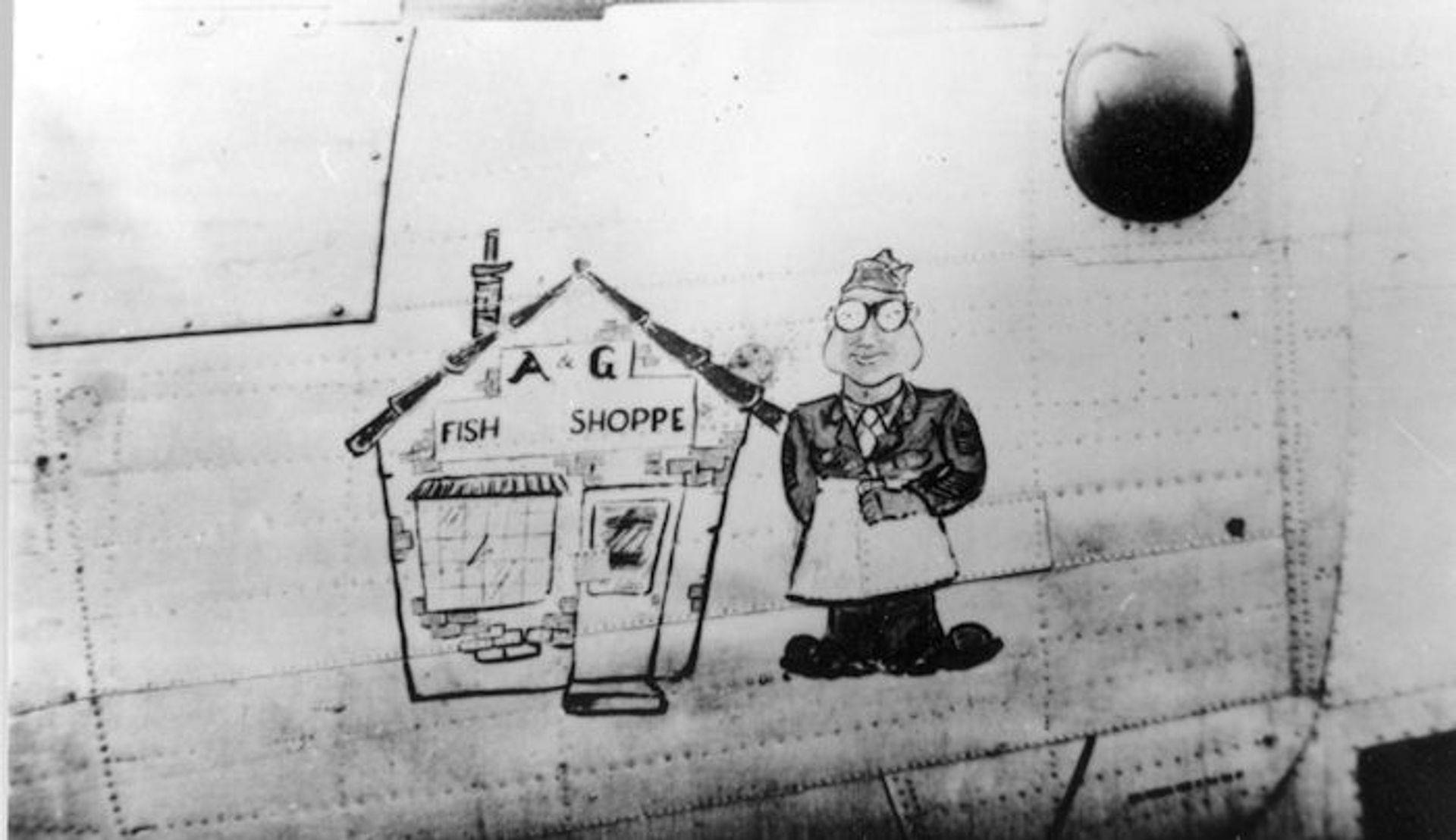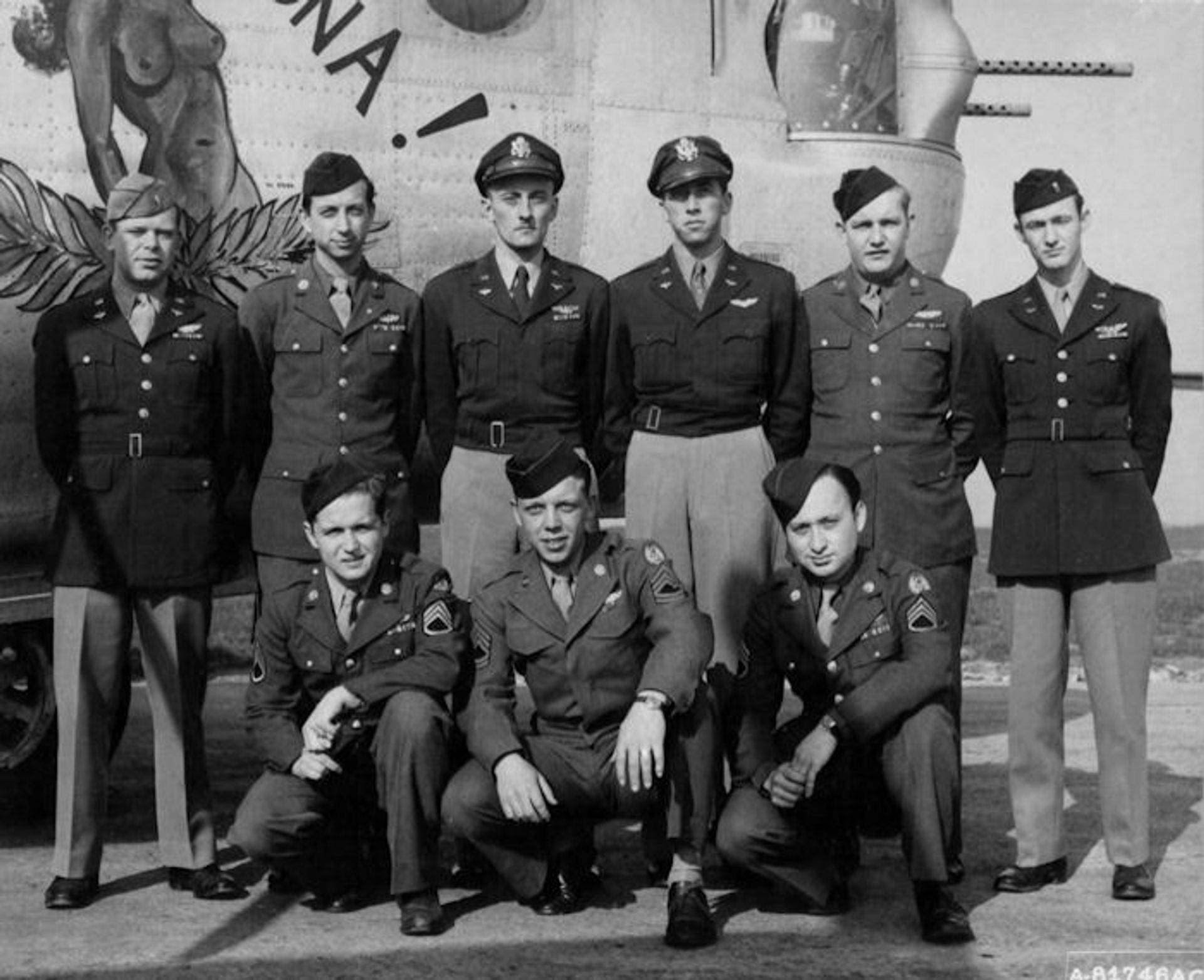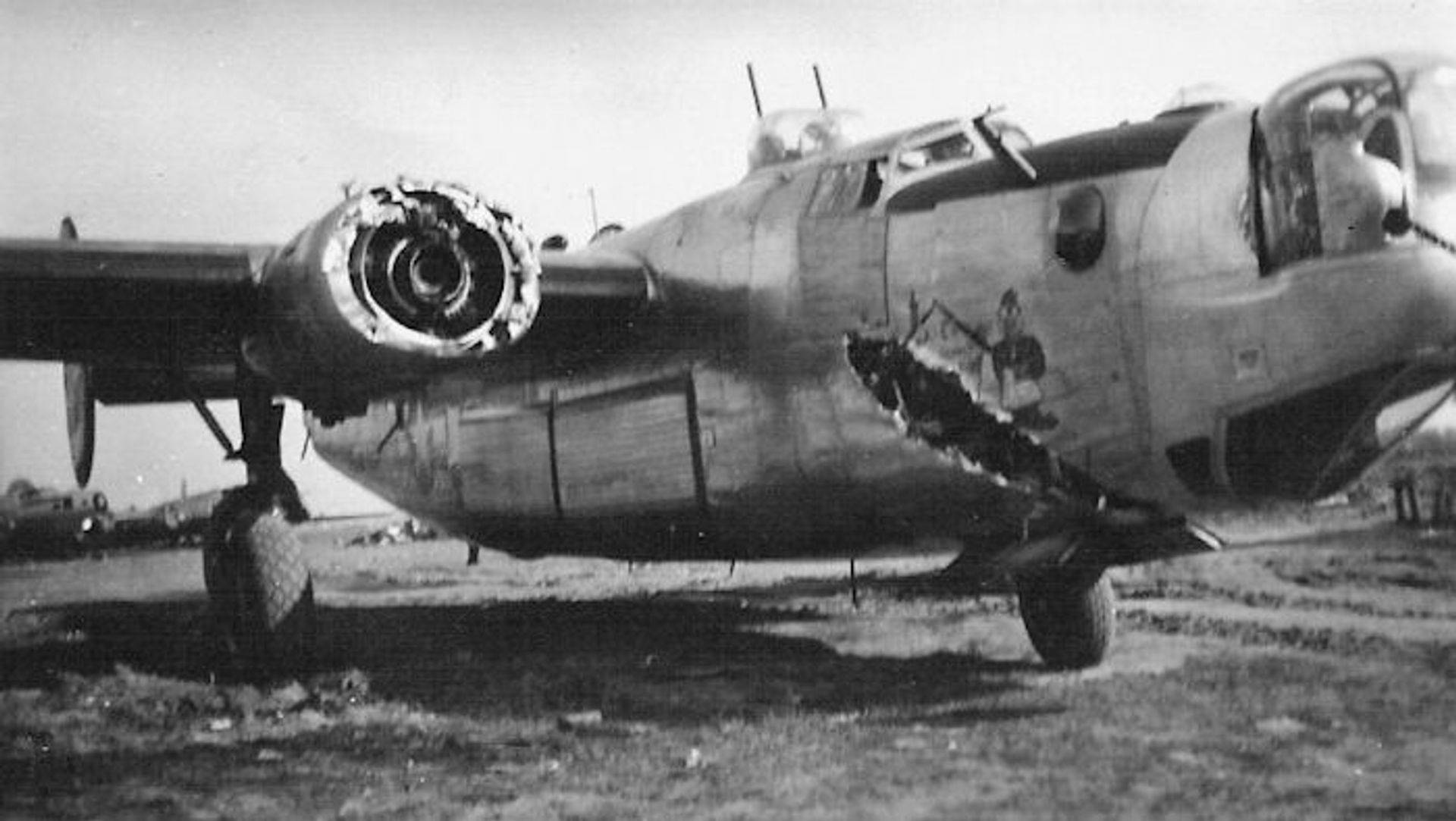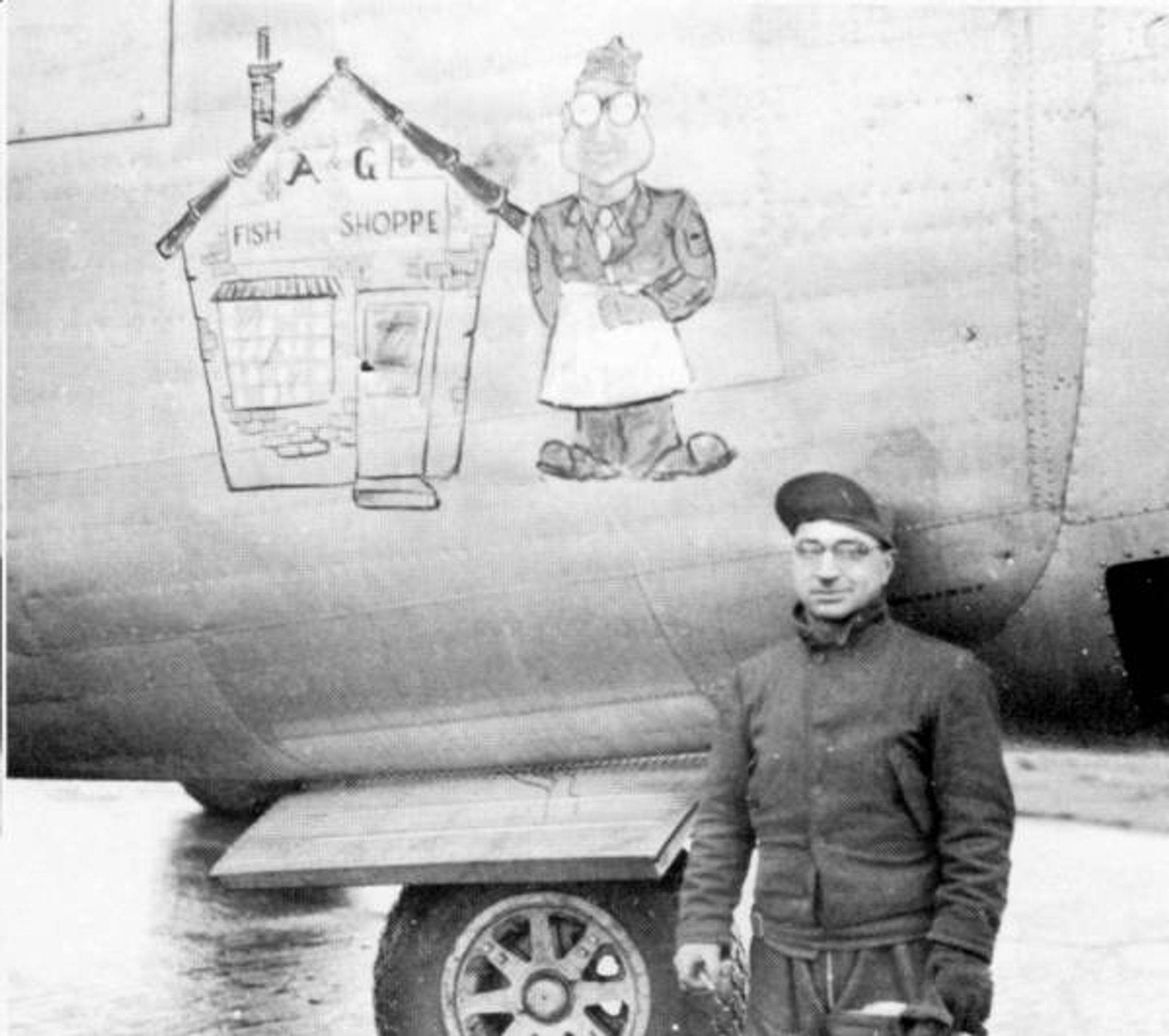458th Bombardment Group (H)
A&G Fish Shoppe
B-24JSH-1-FO 42-50684

Emergency Landing Belgium – March 18, 1945
It is not known when this replacement aircraft arrived at Horsham St. Faith, but it can be surmised, by the date of its first mission on October 22, 1944, that it was shortly before that date. This aircraft was designated as a lead ship, and thus was placed in the 755BS where it remained throughout its time in the 458th. A total of 14 combat missions were completed in this aircraft by ten crews in five months. After the mission to Berlin on March 18, 1945 (detailed below) it is unknown what became of the aircraft. It did not return to the 458th.
Missions
| Date | Target | Pilot | 458th Msn | Pilot Msn | Cmd Pilot | Ld | RCL | Sqdn | A/C Msn | Comments |
|---|---|---|---|---|---|---|---|---|---|---|
| 22-Oct-44 | HAMM | HAYZLETT | 137 | 21 | BOOTH | D1 | B+ | J3 | 1 | |
| 26-Oct-44 | MINDEN | HAYZLETT | 138 | 22 | BETZOLD | L3 | B+ | J3 | 2 | |
| 02-Nov-44 | BIELEFELD | BENO | 140 | 7 | JAMISON | L1 | B+ | J3 | 3 | NTG FLAK SUIT CAUGHT IN TOGGLE SW-RELEASED 20mi SHORT |
| 04-Nov-44 | MISBURG | HAYZLETT | 141 | 23 | O'NEILL | L1 | B+ | J3 | 4 | |
| 06-Nov-44 | MINDEN | LAMERS | 143 | 21 | DARELIUS | D1 | B | J3 | 5 | |
| 06-Dec-44 | BIELEFELD | BRUMBY | 153 | 22 | HOGG | L1 | B+ | J3 | 6 | |
| 10-Dec-44 | BINGEN | LOCKRIDGE | 154 | 23 | JAMISON | L1 | B | J3 | 7 | |
| 18-Dec-44 | KOBLENZ | ANDERSON | REC | -- | BETZOLD | D1 | B | J3 | -- | RECALL DUTCH ISLE |
| 24-Dec-44 | SCHONECKEN | ANDERSON | 157 | 11 | WAGNER | L | B | J3 | 8 | |
| 27-Dec-44 | NEUNKIRCHEN | LOCKRIDGE | 159 | 24 | WILLIAMSON | L1 | B | J3 | 9 | |
| 30-Dec-44 | NEUWIED | LOCKRIDGE | 161 | 25 | JAMISON | L1 | B | J3 | 10 | |
| 08-Jan-45 | STADTKYLL | BRUMBY | 167 | 25 | not listed | L1 | B | J3 | 11 | |
| 14-Feb-45 | MAGDEBURG | CHIMPLES | 181 | 19 | BRECKENRIDGE | L3 | B | J3 | 12 | |
| 17-Mar-45 | HANNOVER | WILLIAMS, DK | 205 | 14 | B | J3 | 13 | |||
| 18-Mar-45 | BERLIN | MITCHELL | 206 | 26 | L3 | B | J3 | 14 | EMERG LAND BELG B-58 |
Incident – March 18, 1945

Don Peters, son of co-pilot Ray Peters
The most memorable mission was on March 18, 1945. Target Berlin. 3700 gallons of fuel, 4-2000 pounders. Other missions they had taken several hundred flak holes to the plane, surface damage, and even the loss of most of one of the vertical rudders. On this flight they took only three hits, but they counted!
They were flying a ship named The A&G Fish Shoppe, approaching the target at 19000 ft. The flak started as they got over the target area. They dropped their load. Then shortly they felt a “lift” – flak. They had taken three hits. One to the #3 engine, which hit the oil line inside. Two other hits through the bomb bay. One wiped out the hydraulic lines, the other took out the bundle of electrical wires.
The #3 engine ran out of oil and the engine “froze”. The hydraulic lines had been cut, so they were unable to feather the prop. Eventually it started to “windmill” backwards and started to send vibrations throughout the ship. All this was going on while there was still flak going off and bouncing them around. The vibrations worsened, they were losing control of the plane and they dropped out of formation. They regained control to a degree and came out of the bomb run at 9000 ft. Dad,who had been bothered by Claude the whole time finally turned to him and said “what?”. Claude responded by saying “here” and held up one end of the electrical wire bundle. Dad said it was fanned out and looked just like a giant bouquet of flowers. Then looking down, he noticed most of the control panel was dead. Some basic dials were working as Claude had started the putt-putt and was able to get some electrical power to the plane. The #3 engine had the electrical generator, so no engine meant no power. Meanwhile the plane was vibrating even worse than before. Mitch gave the order to bail out. Claude said, “I can`t”. Mitch said, “why?”. Claude answered, “My chute is soaked with hydraulic oil!”. Mitch said, “Alright, I’m staying”. And one by one all the crew said the same.
The propeller was windmilling faster and faster when all of a sudden it twisted itself off from the plane. The good news was that the vibrating stopped and they regained full control of the plane. The bad news was what Dad saw outside his window. There, just a few feet from him, was an 8 foot propeller flying loose in “formation” with the plane. It was caught in the wing’s slip stream and just seemed to bob and float along with them. At the time it seemed forever, but shortly the tip of the prop hit the side of the plane just below Dad’s feet, cutting through the fuselage and banging on the cockpit’s armor decking, (Dad’s legs eventually turned black and blue from his knees on down) past the feet of the kneeling bombardier navigator, leaving a 3-1/2 foot by 11 foot gash in the bottom of the plane.
Meanwhile, most of the crew was in the waist. Claude had gone up front to get some maps for the navigator.(Mitch wanted to know where they were and have a heading). The rest were tossing out all things unneeded to lighten the plane. For the moment they had fighter protection as one of the “Little Friends” had dropped down to protect them. A sight that brought comfort to the crew. Eventually he had to leave them. They had plotted the shortest course to Allied lines in Belgium.
The B-24 went its way – the fighter, his way back to base. En route they lost the #2 engine. They red-lined the remaining two engines for almost two hours in order to make Belgium. They were following some railroad tracks, when all of a sudden the air filled with flak. They had passed over a train that had an 88 mounted on a flat car and they were being shot at. Taking evasive maneuvers, they avoided being hit.
Finally they crossed the allied lines and they were looking for a place to set down. Then the #4 engine started to act up. They remembered passing over a small airfield which they had dismissed because of its size, but with the #4 engine acting as though it was going to quit, small was better then none. They turned and headed for the field. The #4 engine quit. They flew/glided with one engine until they were within sight of the field.

Then, upon approach, the #1 engine quit. Before this had happened, Dad and another crew member had crawled down into the nose wheel compartment and “hand threw” the nose gear out into landing position. Claude and others had hand cranked down the wing gear. Remember – no hydraulics. The rest of the crew had moved to the waist and tail of the plane. Two of them had attached parachutes to the side windows in preparation for braking action upon landing. So now they were in a dead-stick situation – no power, no flaps, no brakes, and a short muddy runway. The plane mushed in, touched down, and everyone ran to the tail, keeping the nose up. The chutes were deployed. The runway ran out and they plowed to a stop in a muddy field. Everyone bailed out and ran from the plane fearing an explosion. Nothing happened. They went back to the plane and waited for help to arrive. They measured the fuel supply and found less then 50 gallons in the whole plane.
The crew was picked up by allied troops and taken to an airfield, where four days later, they were flown back to England. All Claude could remember about the landing was seeing the Belgian peasants out the waist window. The thing that struck him was that they were wearing cowhide coats of all colors and were lined up and resting on the fence next to the runway, watching them land.
See Capt Charles E. Mitchell Crew page
Inspiration for Nose Art

Disposition
B-24JSH-1 FO 42-50684 A&G FISH SHOPPE
NMF
RCL: D J3 (755)
RCL: B J3 (755)
Lead aircraft equipped with H2X.
Radio call letter changed from D to B between 2 & 4 Nov 44.
Radio call letters shown as D+ and B+ on formation plans in Oct & Nov 44.
Sustained damage on the 18 Mar 45 mission to Berlin when a runaway prop came off and sliced into the right side of the nose. Landed in Belgium. No more combat missions with 458th BG.
Probably transferred after repair to another unit (467th BG has been suggested along with the name SOUTHERN CLIPPER but no trace on 467th BG records seen).
RZI 13 Aug 45 – Altus, OK, 21 Oct 45.
(Info Courtesy: Tom Brittan)
